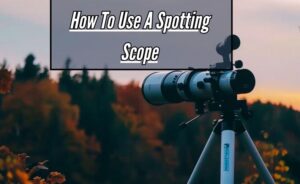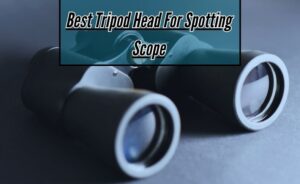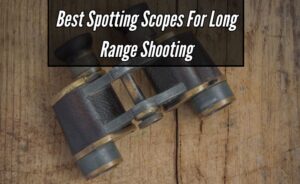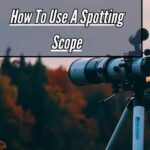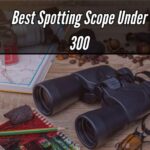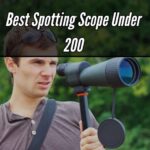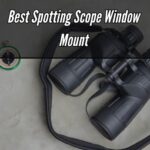A spotting scope can be your greatest friend when it comes to accurate shooting. Shooters can zoom in on faraway targets with this useful function, which makes it easier to detect hits and modify their aim accordingly. However, pointing and gazing alone is not enough to use a spotting telescope properly. Success on the range or in the field depends on your ability to set up, concentrate, and interpret what you see through the scope.
How To Use A Spotting Scope For Shooting? The first step in using a spotting scope for shooting is to mount it on a sturdy surface so that you can see your target clearly. To improve visibility, adjust the magnification and focus settings. To identify impacts and adjust your aim as needed, use the scope. For optimum results, keep the lens clean on a regular basis.
We’ll go over all the fundamentals of using a spotting scope for In this article, we’lling, including how to properly align the scope with your rifle and select the appropriate magnification. Gaining proficiency with a spotting scope can help you improve your shooting abilities, regardless of your experience level.
The Beginner’s Guide to Using a Spotting Scope for Shooting
I hope you enjoy exploring the amazing world of spotting scopes! A spotting scope is an essential instrument that may improve your accuracy and precision when shooting, regardless of your expertise level. Using a spotting telescope for shooting may be made simple and pleasant by following the steps outlined in this guide.
Choosing the Right Spotting Scope:
Selecting the ideal spotting scope for your requirements is the first step in utilizing one efficiently. Think about things like build quality overall, objective lens size, and magnification. When these components are in balance, the view is clear and sharp, making it easier for you to identify your objective.
Setting Up Your Spotting Scope:
It’s time to set up your ideal spotting scope when you’ve chosen it. Locate a level, stable platform to mount your scope on. To reduce vibrations and increase stability, attach it to a tripod. To obtain a sharp image, adjust the focus wheel and eyepiece.
Understanding Magnification and Field of View:
For shooting to be effective, one must understand magnification. Increased magnification reduces your range of vision while improving your ability to perceive far-off objects. To effectively track and spot your target, you must strike the correct balance between magnification and field of view.
Using the Spotting Scope in the Field:
Make the most of your spotting scope’s portability when you’re out in the field. Evaluate the area methodically, first taking in a large region before focusing in as you identify possible targets. Your chances of spotting games and hitting your mark are increased by using a thorough approach.
Adjusting for light conditions:
How clearly you can see through your spotting scope is mostly dependent on the lighting conditions. To lessen glare in direct sunlight, think about using sunshades or lens shades. To get a brighter view in low light, enlarge the exit pupil size.
Maintenance and Care:
You must perform routine maintenance on your spotting scope to guarantee that it stays in excellent condition. Use a microfiber cloth or lens brush to keep the lenses clean. When not in use, keep your scope stored in a secure case to guard against damage and dust buildup.
Frequency of use of a spotting scope for shooting

Spotting scopes are highly valued for their accuracy and adaptability, and the shooting community uses them extensively. They provide a number of benefits that make shooting much more enjoyable. Let’s examine how often shooters use spotting telescopes and explore the distinct factors that drive their widespread use.
Tactical Advantage in Varying Terrain:
Environmental elements such as changing light levels, atmospheric disturbances, and intricate topography present considerable obstacles in the dynamic world of filming.
Spotting scopes, with their sophisticated optics and adjustable functions, provide a tactical edge by easing these difficulties and guaranteeing reliable performance in a variety of shooting situations.
Enhancing Collaboration Through Optics:
Spotting scopes play a crucial role in fostering collaborative synergy within team shooting dynamics by serving as a bridge between shooters and spotters. Spotting telescopes enable spotters to carefully examine target dynamics and provide vital information to shooters, resulting in smooth coordination and optimal firing efficiency. This is achieved by offering spotters increased vision and clarity.
Amplifying Performance with Innovative Features:
Spotting scope technology is still evolving, changing the shooting environment and bringing in a new era of unheard-of innovation and performance improvement.
Spotting scopes develop in step with shooters’ ever-changing needs, from state-of-the-art optical improvements to integrated digital features, guaranteeing maximum performance and flexibility in the face of changing obstacles.
Expanding Horizons Beyond Shooting Parameters:
Spotting scopes are useful for a wide range of outdoor activities, from nature photography to observing wildlife, outside of the typical shooting range.
Because of their intrinsic adaptability, spotting scopes may be used for a wider range of purposes, which makes them an essential tool for outdoor lovers looking for unmatched visual clarity and immersive experiences.
Navigating Challenges Through Enhanced Optics:
With the unmatched optical clarity and resolution that spotting scopes provide, shooters may confidently and precisely traverse challenging situations. Spotting telescopes are a clear benefit when it comes to locating far-off targets or determining where bullets should be fired. They enable shooters to get past barriers and get the best results possible under any shooting condition.
Spotting Scope Requirements for Sport Shooters
The performance and accuracy of sport shooters can be greatly enhanced by possessing the appropriate spotting scope. The following is a summary of the essential criteria to take into account when selecting a spotting scope:
Magnification and Lens Quality:
Sport shooters place a premium on a spotting scope’s lens quality and magnification power. To adjust to varied distances, choose scopes with adjustable magnification. Sharp, crisp images are guaranteed by high-quality lenses, which let shooters identify targets precisely.
Durability and Weather Resistance:
Sport shooters frequently practice in a variety of weather scenarios, so selecting a spotting scope that can tolerate rigorous use and environmental elements like rain, fog, or extremely high or low temperatures is crucial. Find scopes with characteristics that are waterproof and fog-proof, as well as robust construction.
Portability and Weight:
Sport shooters may need to move around a lot, so having a spotting scope that is lightweight and portable is helpful. Think of small designs that don’t add needless bulk and can fit neatly into a shooting bag or backpack.
Field of View and Eye Relief:
The ability to see a wider area without having to constantly move the scope is provided by a wide field of vision. Having enough eye relief is also essential for comfortable, prolonged viewing periods without eye strain, especially for individuals who wear glasses.
Image Clarity and Colour Fidelity:
Sport shooters must possess the capacity to see minute details and determine target colors with accuracy. Selecting spotting scopes with cutting-edge optics technology that produces sharp visuals and accurate color reproduction will improve your accuracy when shooting.
Mounting Compatibility:
It is essential for the spotting scope to be compatible with several mounting systems, including window mounts for tripods, in order to stabilize it while in use. To allow for flexibility in shooting configurations, make sure the selected scope is simple to mount onto various mounting choices.
Price and Value:
Budgetary constraints should not be ignored, but affordability and performance must be balanced. Make an effective financial investment in a spotting scope by giving top priority to characteristics that suit your individual shooting requirements and preferences.
Essential Features of Spotting Scopes for Sport Shooters

Sport shooters find spotting scopes to be invaluable instruments that provide accuracy and clarity to improve their shooting experience. When choosing a spotting scope made specifically for sport shooters, keep the following important factors in mind:
Precision Optics for Target Acquisition:
For sport shooters, having the best possible optic precision is essential since it allows them to acquire targets quickly and precisely. Look for spotting scopes with premium lenses and coatings that produce crisp, clear images so that targets may be clearly seen even in dimly lit areas or at a distance.
Tactical Design for Tactical Advantage:
A shooter’s tactical advantage on the field can be greatly impacted by the design of their spotting scope. Seek out scopes with an ergonomic, streamlined design with tactical additions like textured grips and simple controls.
A well-made scope improves handling and usability, enabling shooters to stay focused and precise in high-stress situations.
Advanced Technology for Enhanced Performance:
With cutting-edge capabilities built into spotting scopes, embrace modern technology to improve your shooting performance. Examine alternatives that include built-in image stabilization, ballistic calculators, and rangefinders. These features give shooters useful information and stability for more precise shot placement and enhanced performance.
Durable Construction for Outdoor Resilience:
Sport shooting frequently takes place in challenging outdoor settings where toughness is essential. Give priority to spotting scopes made of sturdy materials with weather-resistant seals to endure the weather.
With a sturdy scope, shooters may easily navigate a variety of terrain and weather conditions without sacrificing performance. Durability and lifespan are ensured.
Adaptability for Versatile Shooting Scenarios:
For sport shooters who deal with a variety of shooting situations, versatility is essential. Select spotting scopes with replaceable eyepieces, customisable magnification levels, and accessory compatibility for mounting systems and tripods to provide maximum versatility.
Shooters can tailor their setup for the best results in a variety of shooting disciplines and conditions by using an adjustable scope.
Warranty and Customer Support:
Use spotting scopes that come with extensive warranties and dependable customer service to safeguard your investment. Select trustworthy brands that are well-known for their dedication to excellence and client happiness.
Shooters can concentrate on developing their skills and reaching their shooting objectives without worrying about the longevity or dependability of their equipment when they have a strong warranty that guarantees peace of mind and quick resolution of any difficulties.
Enhance Your Accuracy: Unveiling the Secrets of Spotting Scope Techniques for Marksmanship
Discerning the nuances of spotting scope techniques is the first step in improving your shooting skills. Our journey through this book will take you through uncommon perspectives and tactics that will improve your accuracy and enhance your shooting experience.
Optical Finesse and Image Clarity:
Investigate the subtleties of optical grace and image clarity to start your path towards improved accuracy. Examine the relationship between sharper, clearer photos and various elements like lens quality, coatings, and cutting-edge technology.
Shooters are better equipped to locate and engage targets with accuracy when they are aware of these subtleties, which might influence their decision-making process.
Efficient Target Acquisition Strategies:
The ability to acquire targets with efficiency is necessary to get pinpoint accuracy. Learn how to concentrate quickly, change focus quickly, and adjust to various shooting situations. Gunners can gain a competitive edge in fast-paced shooting situations by perfecting these techniques, which enable them to pinpoint targets with accuracy and speed.
Robust Construction and Environmental Resilience:
Durability and resistance to the elements are important components of spotting scope performance that are sometimes neglected in the quest for precision.
Find out how to guarantee accuracy and dependability in inclement weather by choosing a scope with sturdy construction and weatherproof features. Find out why having a spotting telescope that performs well in all types of weather conditions is beneficial.
Seamless Integration with Shooting Accessories:
Spotting scopes may be easily integrated with a variety of shooting equipment to improve your marksmanship. Consider the ways in which mounts, bipods, and data recording devices can enhance stability, user-friendliness, and data-driven modifications. Experience the competitive advantage of a spotting scope that easily attaches to accessories to improve accuracy and shooter performance.
Effective Communication for Collaborative Success:
Improve your marksmanship by working together as a spotter and shooter to communicate effectively. Acquire communication skills that promote data exchange, accurate feedback, and understandable language. Develop a cooperative mindset that improves coordination, which will increase accuracy and success on the range.
Through the Lens: Maximizing the Potential of Spotting Scopes for Shooting Success

The importance of spotting scopes in the world of shooting sports is sometimes understated but cannot be denied. These optical devices give shooters a good view of far-off targets and important details, making them vital tools for improving accuracy and precision.
It’s critical to comprehend how to maximize the use of spotting scopes in order to fully realize their potential and improve shooting effectiveness. This is a thorough guide designed to help shooters get the most out of these essential instruments.
Understanding Spotting Scopes: A Primer
It’s crucial to understand the fundamentals of spotting scopes before moving on to more sophisticated methods. Whether observing targets, wildlife, or landscapes, these portable telescopes are perfect because of their ability to deliver magnified views of distant objects.
Shots may examine targets with unmatched clarity and detail because of the larger fields of view and higher magnification settings of spotting scopes, which are different from riflescopes.
Choosing the Right Spotting Scope: Matching Optics to Needs
To maximize shooting performance, the right spotting scope selection is essential. The efficacy of a target shooting scope is determined in large part by factors like optical quality, objective lens size, and magnification output.
To select a spotting telescope that fits their purposes, shooters should evaluate their individual preferences and needs while taking into account factors including shooting distance, ambient conditions, and financial limitations.
Setting Up for Success: Proper Spotting Scope Placement
A spotting scope’s best performance depends on its setup and alignment. It is imperative for shooters to guarantee that their spotting scope is firmly fixed on a sturdy tripod and positioned at the ideal height and angle to provide comfortable viewing.
Furthermore, optimizing shooting efficiency and reducing eye strain can be achieved by customizing the focus and diopter settings to each individual’s eyesight. This will also greatly improve clarity and sharpness.
Utilizing Spotting Scopes for Shot Spotting and Correction
Two of the primary applications of spotting scopes in shooting sports are shot spotting and correction. Shooters can assess shot placement, identify patterns or deviations, and make in-the-moment modifications to their equipment, technique, or aim by using a spotting telescope to view the bullet impact sites on their targets. To improve shooting techniques and achieve precise, reliable results, this feedback loop is quite beneficial.
Beyond the Range: Spotting Scopes for Scouting and Observation
In addition to being important equipment for observation and reconnaissance in the field, spotting scopes can also be used off-range. For monitoring wildlife, topographical features, or distant objects, spotting telescopes provide unparalleled magnification and clarity, whether you’re hunting, birdwatching, or participating in outdoor sports. They are a must-have accessory for outdoor enthusiasts who want to explore and enjoy the great outdoors because of their portability and flexibility.
Conclusion:
In conclusion, developing your shooting skills with a spotting scope offers you a world of accuracy and precision. You may greatly improve your shooting experience by becoming familiar with its settings and features. Do not forget to use an appropriate approach and to modify the scope to meet your requirements.
A spotting telescope can be your go-to tool for hitting the mark when hunting or target shooting. Thus, spend some time learning about its possibilities and implementing them into your shooting style. You may quickly increase your accuracy and experience the rush of effortlessly hitting your targets if you have patience and practice.
Frequently Asked Questions (How To Use A Spotting Scope For Shooting)
What is a spotting scope, and why is it essential for shooting?
A spotting scope is a portable telescope that shooters use to clearly view targets at a distance. The ability to see targets more clearly is essential for shooting since it improves aim and accuracy. Spotting scopes are designed to magnify distant objects.
This helps the user see details such as bullet holes or impacts, which can be important while aiming or assessing shooting accuracy. They can also assist in identifying environmental elements that could affect the shot, such as obstructions or the direction of the wind. In general, shooters need a spotting scope to increase their accuracy and performance in the field or on the range.
How do I set up and stabilize my spotting scope for shooting?
In order to eliminate shaking and guarantee good viewing, start by setting up and stabilizing your spotting scope for shooting on a sturdy surface, such as a tripod. Maintaining the tripod’s stability requires adjusting its legs to the proper height. After that, firmly fasten the spotting scope to the tripod head, making sure it is level and aimed at the desired location.
To reduce vibrations brought on by the wind or movement, make use of any stabilization mechanisms that your tripod or scope may have. Furthermore, especially in windy circumstances, think about adding counterweights or sandbags to the system to better stabilize it. Finally, before firing, make sure you have a clear, accurate picture of your target by adjusting the focus and magnification settings.
What are the best practices for using a spotting scope during shooting?
For the best results when using a spotting scope while shooting, there are a few best practices to follow. To have a good view of the target area, first place the spotting scope behind or next to the shooter. To see the target and any impacts clearly, adjust the magnification and focus settings. Minimize movement, and use a solid tripod to keep the scope steady. In order to efficiently coordinate observations and corrections, communicate with spotters or other shooters.
For accurate measurements and adjustments, make use of the scope’s ocular reticle or grid patterns. Check the lighting and wind conditions frequently and make the necessary adjustments to the settings. Finally, get comfortable and efficient with the spotting scope by practicing its use during shooting sessions. These procedures guarantee precise observation and improve shooting efficiency.
How can I maintain and care for my spotting scope?
For your spotting scope to last a long time and function at its best, care and maintenance are necessary. First and foremost, to keep your scope safe from dust, moisture, and any damage, always store it in a protective case while not in use. Use a soft brush or lens cloth to carefully remove debris and fingerprints from the lenses on a regular basis. Steer clear of rough objects or abrasive cleaning agents that could scratch the lenses.
To further avoid stiffness or corrosion, lubricate the movable parts—such as focus knobs and eyepieces—with a tiny bit of silicone oil. Finally, to ensure that your spotting scope lasts as long as possible, keep it out of the harshest environments and temperatures. For many years to come, your spotting scope will remain in excellent condition with routine maintenance and appropriate care.
Are there any additional accessories that can enhance my shooting experience with a spotting scope?
Yes, you can improve your spotting scope shooting experience with a few extras. You can take pictures or films of your subject or surroundings by attaching a digital camera or smartphone with a digiscoping adapter. In varying lighting situations, eyepiece filters can improve visibility by reducing glare or enhancing contrast. In order to provide a clearer view, sunshades can reduce glare and shield the lenses from direct sunlight.
More height and stability can be obtained using tripod extensions or stabilizers for improved positioning and observation. Transporting your spotting scope is made easier, and your equipment is protected when traveling using carrying cases or backpacks made just for that purpose. By offering simplicity, adaptability, and enhanced performance, these accessories go well with your spotting scope and improve your shooting experience.
What safety precautions should I follow when using a spotting scope for shooting?
It is imperative to put safety first while using a spotting scope for target shooting. To start, make sure the tripod and spotting scope are constantly positioned steadily and securely to avoid mishaps. To prevent unintentional harm or damage, you should never aim your handgun or spotting scope at anything other than your intended target. To avoid any possible accidents, transport the spotting scope in a protective case. In order to avoid mishaps, you also need to pay attention to your surroundings and the other shooters at the range.
This requires clear coordination and communication. Last but not least, always abide by the recommended weapon safety procedures, such as holding off on pulling the trigger until you’re ready to shoot and keeping the gun unloaded until it’s ready to use. By taking these safety measures, you can make sure that using your spotting scope is both safe and pleasurable.


